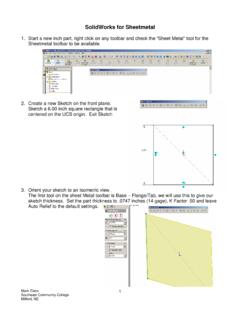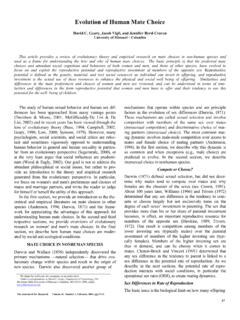Transcription of Building a Cycloidal Drive with SOLIDWORKS
1 Building a Cycloidal Drive with SOLIDWORKS By Omar Younis A Cycloidal Drive is a mechanism used in the engineering world as a speed reducer for an input shaft while reversing its direction. It is able to do this for high ratios in a small space. They do this using a rotor that has a unique motion (see Cycloidal Drive Motion ). In this tutorial I will be going over how to make a Cycloidal Drive in SOLIDWORKS . Some of the features that we will be using are the Parametric Feature on the Equation Driven Curve tool and the CAM Mate used in assemblies. There are five main parts to a Cycloidal Drive : the Rotor, the Output Disk (could equally be an output shaft), the Input Shaft, the Rollers and the Main Housing (See Figure 3). Let s start by making the more complex part of the Cycloidal Drive , the Rotor.
2 Figure 1 Figure 2 Figure 3 Rotor As you can see, the Rotor has a very unique shape (See Figure 4); something that wouldn t be easily constructed using the basic sketch tools that SOLIDWORKS gives you. So what do we do? Luckily SOLIDWORKS comes to our rescue with a tool that will make making this part a breeze, the Equation Driven Curve tool! There are two different types of equations that can be used, Explicit equations and Parametric equations. The Explicit Equations are used when you have a single variable equation such as y = x2. The way Explicit works is that it creates a curve of an equation that you give it from two different points. For example you can make a line based on the curve y = x2 starting from 0 and ending at 10. Using Parametric Curves works the same way as the Explicit but the only difference is that you use two equations to define a curve (an x-component and a y-component).
3 For our purposes we are going to need to use a Parametric Curve because of the two equations needed to define the Rotor. The two equations that define the Rotor s shape are the following: ( ) ( ) ( ) ( ) ( ) ( ) Where [ (( ) )( ) (( ) )] ( ) For the equation we have a say in four parameters. R is the radius of the Rotor that you want, E is the eccentricity (or offset) from the Input Shaft to the center of the Rotor, Rr is the radius of the Rollers and finally N which is the number of Rollers. So to save you guys some time and effort I have taken the equations above and put them in a format that SOLIDWORKS can understand so that you can just copy it into SOLIDWORKS . All you have to do is select the parameters you want.
4 X = (R*cos(t))-(Rr*cos(t+arctan(sin((1-N)*t) /((R/EN)-cos((1-N)*t)))))-(E*cos(N*t)) Y = (-R*sin(t))+(Rr*sin(t+arctan(sin((1-N)*t )/((R/EN)-cos((1-N)*t)))))+(E*sin(N*t)) So now that we have the equations we can start to build our Rotor. For this tutorial I will be using the following parameters for my Rotor: R = 10, E = , Rr = , N = 10. I will also be using the ANSI standard with IPS units. Figure 4 In a new part file create a sketch on the front plane. Next select the Equation Driven Curve tool from the Sketch Entities tools. Once in the Equation Driven Curve Wizard, select the parametric option. Once you have selected the Parametric option, the wizard should change. Now you should have a place to input two equations, one for the x-component and one for the y-component.
5 Input the Rotor s equations for the x and y components in the correct boxes. The next two boxes labeled t1 and t2 are where you put your start and end conditions for the curve. Since we want to have a complete Rotor it would be logical to assume that our t1 and t2 would be 0 and 360 respectively (or 0 to 2 ). Unfortunately SOLIDWORKS doesn t like curves that start and end at the same point in space. So what s the solution? Well, we could make two curves: one that goes from 0 to 180 and then another from 180 to 360 . In fact that is what I tried after I discovered at going from 0 to 360 wasn t a viable option. Unfortunately, even though this gets you the desired shape you want, it comes with a price. What happens is that at the two points were the curves meet an infinitesimally small peek and valley is created making it almost impossible for some assembly mates to work properly; such as a CAM mate.
6 So now what? Well there is a solution to this problem, but it isn t as straight forward as you would think and what helps us is that the Rotor has at least one line of symmetry. Since we want to have tangency around the entire shape, what we need to do is we need to create two halves of the overall shape but not by going from 0 to 180 and then from 180 to 360 . What we actually need to do it create one half of the shape by going from -10 to 190 , create a line of symmetry and remove the extra parts of the line. We then need to take our curve and mirror it about the line of symmetry and finally add a tangent relationship between the two curves. In the Equation Driven Curve wizard under the parametric option after you have entered in your two equations (one for the x-component and one for the y-component) enter -10 for t1 and 190 for t2.
7 They should both be entered in radians not degrees. You can uses the following equation so that all you need to do is enter the desired degree angle you want were the variable x is: (x/360)*(2*pi). Also you can use the following equations for the rotor profile if you are using the numbers I provided earlier: X = (10*cos(t))-( *cos(t+arctan(sin(-9*t)/((4/3)-cos(-9*t) ))))-( *cos(10*t)) Y = (-10*sin(t))+( *sin(t+arctan(sin(-9*t)/((4/3)-cos(-9*t) ))))+( *sin(10*t)) Once you have done that you should see a preview of the curve that will be generated. If you don t see the preview click the Graphics Window and Zoom Fit (which you can do by pressing F on your keyboard) to see it. Click the green check mark to generate the curve. Next draw a centerline that goes through the curve as well as through the Origin and trim the extra parts of the curve with the Power Trim Tool.
8 After that, mirror your curve about the centerline you created in order to create the full Rotor profile. Next, select the two curves you have generated and add a Tangent relationship to them. Congratulations, you have no successfully created the profile of the Rotor for a Cycloidal Drive ! Next step is to extrude (Blind Extrude) so we can get a part. If you are following my dimensions then extrude the sketch to 1 inch. Next we need to add a few holes to the Rotor; the hole that will allow the Input Shaft to spin and the holes needed to spin the Output Disk. The only critical dimension is that the hole for the Input Shaft is in the middle of the Rotor and that the holes for the Output Disk are in line with each lobe of the Rotor. Another thing is that the diameter for the hole that spin the Output Disk equal to the size of the pins that the Output Disk has added to your eccentricity value.
9 In my case I wanted the pins of the Output Disk to be 2 inches in diameter which meant that the holes needed to be inches in diameter since the eccentricity value that I am using is inches. So for those who are using my dimensions, below is a quick drawing telling you the dimensions of the holes and there they are located. To get the holes in the right position, create Hole 1 as shown below and then linear pattern the other holes. This will line up the holes perfectly with the lobes. Once you are done with the holes, you are now done with the Rotor. Hole 1 Rotor Housing Rotor Shaft Roller Output Disk Assembling the Drive Now that we have all the parts build we need, we can start assembling the Drive . The Drive consists of one sub-assembly which we will be doing first.
10 First, start of by opening a new assembly file in SOLIDWORKS . Once the file opens the insert component wizard should automatically be selected. First toggle the show/hide origins so that they are being showed. Next clip the Browse button in the insert component wizard and open your rotor housing part. Once you have opened the file, you should see two origins: one on the Rotor Housing part and on that is floating in space (the assembly s origin). Move your mouse over to the Assembly s origin. Your curser should snap to the assembly origin once you place it near it. Both origins should have merged to show one. Once that happens, click to place the Rotor housing part on the Assembly s origin. Next click the Insert Components button located in the Assembly tab.



